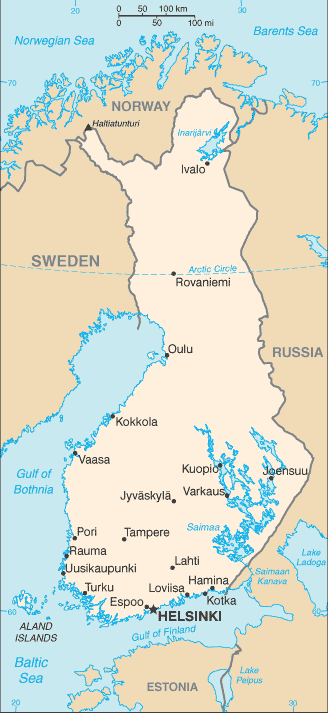Finland
The Republic of Finland (Finnish: Suomen tasavalta, Swedish: Republiken Finland) is a Nordic country in northeastern Europe, bordered by the Baltic Sea to the southwest, the Gulf of Finland to the south and the Gulf of Bothnia to the west. Finland has land frontiers with Sweden, Norway and Russia and a maritime border with Estonia. The Åland Islands, off the southwestern coast, are under Finnish sovereignty while enjoying extensive autonomy. The beginning of Finland's nearly 700-year association with the Kingdom of Sweden is traditionally connected with the year 1154 and the alleged introduction of Christianity by Sweden's King Erik. Actually many of the Finnish pagans were already Christened hundreds of years before. Swedish became the dominant language of administration and education; Finnish chiefly a language for the peasantry, considered useful mainly for printing religious literature. During the 18th century, virtually the whole of Finland was twice occupied by Russian forces (1714–1721 and 1742–1743), by the Finns known as the Greater Wrath and the Lesser Wrath. After that, "Finland" became the predominant term for the area — both in domestic Swedish debate and in Russian propaganda promising "liberation from Swedish oppression". In 1808, Finland was conquered by the armies of Russian Emperor Alexander I and thereafter remained an autonomous Grand Duchy in personal union with the Russian Empire until the end of 1917. To sever the cultural and emotional ties with Sweden, the Finnish language was ardently promoted by both the imperial court and the Finnish government and a strong nationalist movement, known as fennomania, since about 1860s. Milestones in this development were the publication of what would become Finland's national epic, the Kalevala, in 1835; and Finnish getting a legally equal status with Swedish in 1892. On December 6, 1917, shortly after the Bolshevik Revolution in Russia, Finland declared its independence. The independence was recognised by Bolshevist Russia, but the following civil wars in Russia, in Finland and activist expeditions to White Karelia and to Aunus complicated the relations. The Finnish–Russian border was agreed on only with the Treaty of Tartu in 1920. During World War II, Finland fought the Soviet Union twice: in the Winter War of 1939–1940 and again in the Continuation War of 1941–1944 (with support from Germany). This was followed by the Lapland War of 1944–1945, when Finland forced the Germans out of northern Finland. Treaties signed in 1947 and 1948 with the Soviet Union included obligations and restraints on Finland vis-à-vis the Soviet Union as well as further territorial concessions by Finland (compared to the Moscow Peace Treaty of 1940). After the Second World War, Finland was in the grey zone between western countries and Soviet Union. The "YYA Treaty" (Finno-Soviet Pact of Friendship, Cooperation, and Mutual Assistance) gave the Soviet Union some leverage in Finnish domestic politics. Many politicians, like President Kekkonen (1956–81), used their relations with the Kremlin to solve party controversies, which meant that the Soviet Union got even more influence; other people worked single-mindedly to oppose the communists. When the Soviet Union fell in 1991 Finland was surprised and suffered economically, but was free to follow her own course and joined the European Union in 1995, where Finland is an advocate of federalism contrary to the other Nordic countries that are predominantly supportive of confederalism.
This article is licensed under the GNU Free Documentation License. It uses material from the Wikipedia article "Finland". |
||||||||||

